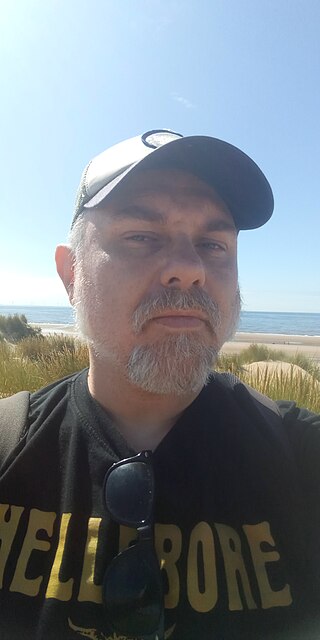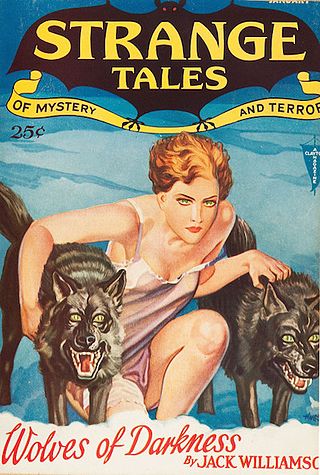 Issue 2 cover | |
| Editor | Maria J. Pérez |
|---|---|
| Country | United Kingdom |
| Website | helleborebooks |
Hellebore is a small press magazine devoted to British folk horror and the occult. It was a World Fantasy Awards finalist in 2022. [1]
 Issue 2 cover | |
| Editor | Maria J. Pérez |
|---|---|
| Country | United Kingdom |
| Website | helleborebooks |
Hellebore is a small press magazine devoted to British folk horror and the occult. It was a World Fantasy Awards finalist in 2022. [1]
Hellebore was founded in 2019 by Maria J. Pérez Cuervo. It started as a folk horror, non-fiction magazine. Its first issue, "The Sacrifice Issue", was published in October 2019, edited by Cuervo, with art direction by Nathaniel Hébert and a cover image by Paul Watson. Cuervo explained she “wanted the aesthetics to evoke (...) the late 60s and 70s, grabbing inspiration from Czech film posters, with a touch of psychedelia, and an old-school fanzine finish.” The name was taken from the hellebore plant, known to alter the physical perceptions of those who consume it and thought to be one of the ingredients of the witches’ flying ointment. [2]
The second issue, "The Wild Gods Issue", was released in May 2020, establishing the pattern of publication of the magazine: two issues a year, in May and October, to coincide with the pagan festivals of Beltane and Samhain. [3] Articles cover film history, literature, folklore, history, and archaeology. [4]
In December 2021, Hellebore published The Hellebore Guide to Occult Britain and Northern Ireland, a travel guide including destinations linked to witchcraft, magic, and megaliths, as well as film, TV, and literary locations. [5] Andy Paciorek of Folk Horror Revival, reviewing the book for Fortean Times , described it as “a gazetteer of British ritual, weird-lore and magical creativity”. [6]
The segment 'Stone Mothers' in Ric Rawling's folk horror film anthology Rewilding (2023) was inspired by an article in Hellebore's The Wild Gods Issue. [7]
Hellebore is a print-only magazine. Cuervo explained she "wanted to make a beautiful object" at a time when "print feels like a small luxury" due to our heavy consumption of digital information. [8] American horror novelist Grady Hendrix said Hellebore had "almost single-handedly" made him "fall in love with magazines again". [9]
Andy Paciorek notes that Hellebore "blossomed in the revival of attention to occulture and folklore". [10] French journalist Laurent Courau suggests Hellebore's success is part of an occult revival happening against a backdrop of economic, ecological, and social crisis. [11]
Dazed includes Hellebore among "a wave of new media" offering a way into a neo-pagan movement that imagines "alternate futures with an eye on the Old Ways". [12] For Green Lung's vocalist Tom Templar, Hellebore is part of the new wave of zines that "have reintroduced readers to the weirdness of the British landscape and its history, from folk horror to alternative heritage sites to archaic rural traditions". [13]
Cuervo explained she wanted Hellebore to be political because folklore is often weaponised by the far right. [14] Fiddler’s Green publisher, Clint Marsh, pointed out that Hellebore addresses the “conservative motif” present in many folk horror stories, taking an anti-fascist stance from its first issue. [15]
Past contributors have included writers John Reppion, Verity Holloway, Roger Clarke, David Southwell, and academics Amara Thornton, Catherine Spooner, Francis Young, and Katy Soar. It has also featured interviews with Ronald Hutton, Alan Moore, and the work of artists and photographers Ellen Rogers, Nona Limmen, and Isa Bancewicz.
Hellebore was a World Fantasy Awards finalist in 2022. [1]

Ramsey Campbell is an English horror fiction writer, editor and critic who has been writing for well over fifty years. He is the author of over 30 novels and hundreds of short stories, many of them winners of literary awards. Three of his novels have been adapted into films.

Fiddler on the Roof is a musical with music by Jerry Bock, lyrics by Sheldon Harnick, and book by Joseph Stein, set in the Pale of Settlement of Imperial Russia in or around 1905. It is based on Tevye and his Daughters and other tales by Sholem Aleichem. The story centers on Tevye, a milkman in the village of Anatevka, who attempts to maintain his Jewish religious and cultural traditions as outside influences encroach upon his family's lives. He must cope with the strong-willed actions of his three older daughters who wish to marry for love; their choices of husbands are successively less palatable for Tevye. An edict of the tsar eventually evicts the Jews from their village.

Eric Frank Russell was a British writer best known for his science fiction novels and short stories. Much of his work was first published in the United States, in John W. Campbell's Astounding Science Fiction and other pulp magazines. Russell also wrote horror fiction for Weird Tales and non-fiction articles on Fortean topics. Up to 1955 several of his stories were published under pseudonyms, at least Duncan H. Munro and Niall(e) Wilde.
Urban fantasy is a subgenre of fantasy, placing supernatural elements in an approximation of a contemporary urban setting. The combination provides the writer with a platform for classic fantasy tropes, quixotic plot-elements, and unusual characters—without demanding the creation of an entire imaginary world.
Weird fiction is a subgenre of speculative fiction originating in the late 19th and early 20th centuries. Weird fiction either eschews or radically reinterprets traditional antagonists of supernatural horror fiction, such as ghosts, vampires, and werewolves. Writers on the subject of weird fiction, such as China Miéville, sometimes use "the tentacle" to represent this type of writing. The tentacle is a limb-type absent from most of the monsters of European folklore and gothic fiction, but often attached to the monstrous creatures created by weird fiction writers, such as William Hope Hodgson, M. R. James, Clark Ashton Smith, and H. P. Lovecraft.

In Cornish folklore, the Owlman, sometimes referred to as the Cornish Owlman, or the Owlman of Mawnan, is an owl-like humanoid creature said to have been seen in 1976 in the village of Mawnan, Cornwall, UK. Reported sightings of it flying above the church tower have led some to believe the creature may have been a barn owl, a species that commonly nests in such places.

Don Webb is an American science fiction and mystery writer, as well as an author of several books on Left Hand Path occult philosophy. He is also a former High Priest of the Temple of Set.
Laird Samuel Barron is an American author and poet, much of whose work falls within the horror, noir, or horror noir and dark fantasy genres. He has also been the managing editor of the online literary magazine Melic Review. He lives in Upstate New York.

Black Static, formerly The 3rd Alternative, was a British horror magazine edited by Andy Cox. The magazine twice won the British Fantasy Award for "Best Magazine" while The 3rd Alternative twice won the same award for Best Small Press. In addition, individual stories published in the magazine won other awards and were reprinted in a number of collections of the year's best fiction.

John Mark Reppion is an English comics writer. He is married to Leah Moore, the daughter of Alan Moore, and he has worked with both on the comic Albion.

Michael "Atters" Attree is a British humourist and performer.

Kevin Burke is an Irish master fiddler considered one of the finest living Irish fiddlers. For nearly five decades he has been at the forefront of Irish traditional music and Celtic music, performing and recording with the groups The Bothy Band, Patrick Street, and the Celtic Fiddle Festival. He is a 2002 recipient of a National Heritage Fellowship from the National Endowment for the Arts.

Gary Joseph Lachman, also known as Gary Valentine, is an American writer and musician. He came to prominence in the mid-1970s as the bass guitarist for rock band Blondie. Since the 1990s, Lachman has written full-time, often about mysticism and occultism. He has written more than 22 books on consciousness, culture, and the western esoteric tradition, written for journals in the US and UK, and lectured on his work in the US and Europe; his books have been translated into more than a dozen languages.
Mike Chinn is a horror, fantasy, science fiction and comics writer from Birmingham, England.

Mitch Horowitz is an American author, publisher, speaker, and television host specializing in occult and esoteric themes. A frequent writer and speaker on religion and metaphysics in print and on television, radio, and online, Horowitz’s writing has appeared in The New York Times, The Washington Post, The Wall Street Journal, Time, and CNN.com, and he has appeared on NPR, CBS News, NBC News, and Vice News. He is the former editor-in-chief of TarcherPerigee and a former vice-president at Penguin Random House. His best-known works are Occult America (2009), The Miracle Club (2018), and Modern Occultism (2023). In 2022, Ferdinando Buscema noted that "Horowitz is among the most articulate and respected voices in the contemporary occulture scene." Horowitz hosts the UFO-themed Discovery/HBO Max television series, Alien Encounters: Fact or Fiction, which the network added to its Wednesday night line-up in June 2024. In July 2024, he joined Elijah Wood's podcast network, SpectreVision Radio, and will be hosting a podcast focused on esoteric and occult topics.

Strange Tales was an American pulp magazine first published from 1931 to 1933 by Clayton Publications. It specialized in fantasy and weird fiction, and was a significant competitor to Weird Tales, the leading magazine in the field. Its published stories include "Wolves of Darkness" by Jack Williamson, as well as work by Robert E. Howard and Clark Ashton Smith. The magazine ceased publication when Clayton entered bankruptcy. It was temporarily revived by Wildside Press, which published three issues edited by Robert M. Price from 2003 to 2007.
Italian occult psychedelia (IOP) is a subgenre of Italian psychedelic music characterized by obscure atmospheres. Italian occult psychedelia was coined by journalist Antonio Ciarletta in an article published by Italian music magazine Blow Up, in January 2012. A festival called Thalassa has occurred in Rome since 2013 to celebrate Italian occult psychedelia bands.
Occult rock is a subgenre of rock music that originated in the late 1960s to early 1970s, pioneered by bands such as Coven and Black Widow.
Folk horror is a subgenre of horror film and horror fiction that uses elements of folklore to invoke fear and foreboding. Typical elements include a rural setting, isolation, and themes of superstition, folk religion, paganism, sacrifice and the dark aspects of nature. Although related to supernatural horror film, folk horror usually focuses on the beliefs and actions of people rather than the supernatural, and often deals with naïve outsiders coming up against these. The British films Blood on Satan's Claw (1971), The Wicker Man (1973) and Witchfinder General (1968) are regarded as pioneers of the genre, while The Witch (2015) and Midsommar (2019) sparked renewed interest in folk horror. Southeast Asian cinema also commonly features folk horror.